April 4th, 2012
| 2 Comments »
March gave us some exceptionally warm days, but the past few weeks haven’t been quite as toasty. Once the sun drops lower in the sky, I’m still shrugging in to sweatshirts and occasionally drawing wool slippers on my feet. I’ve got soup on the mind, with the chill in the air, but not the hearty simmering pots that I dreamed of in January.
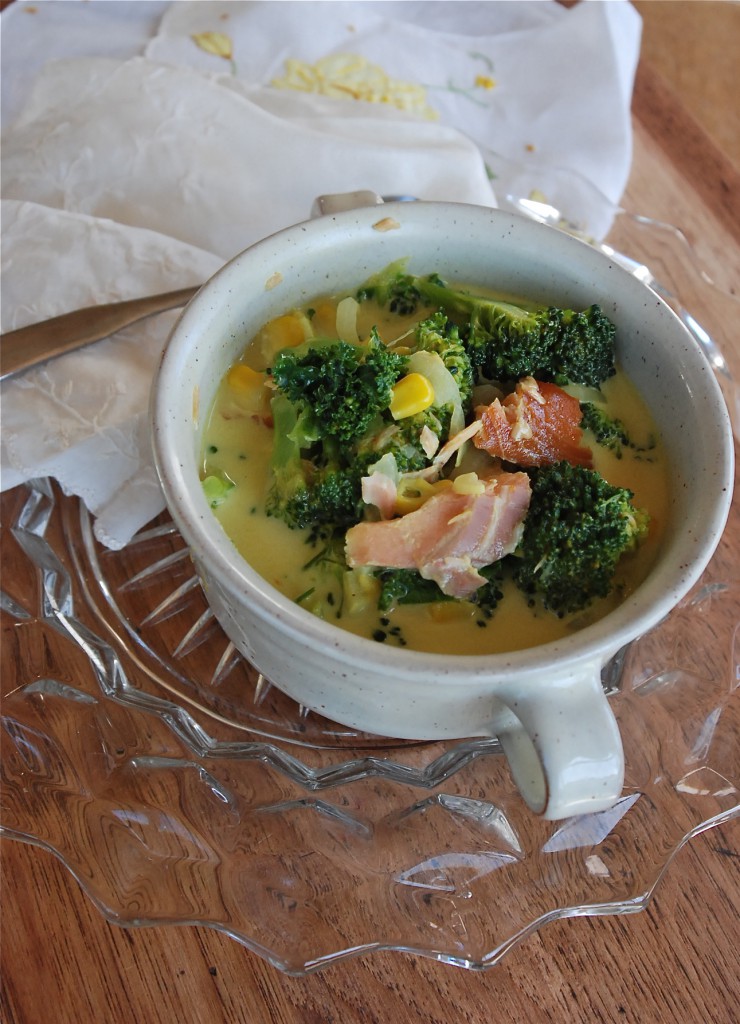
What I’m dreaming about is this succulent chowder, light and refreshing for Spring, brightly colored with vibrant greens and flavored with the rich taste of smoked salmon. This is a simple soup to put together so it won’t be interfering with your outdoor time and you won’t feel bogged down from it when you finish.
The first time I made this soup I think we darn near polished off the entire pan. What was left over was barely worthy of lunch the following day, and instead of slipping this in the ‘Done’ pile and never looking at it again, I kept it front and center, and dropped another chunk of lovely smoked salmon in my grocery cart for a second showing. It’s a surprising recipe, as on first glance it just doesn’t look like a whole lot. Then you lift the spoon to your mouth and taste the coconut milk broth, rich with curry flavor, the delicious vegetables and then, the sharp smoky fish. It’s a bit sweet, it crunches and it delights.
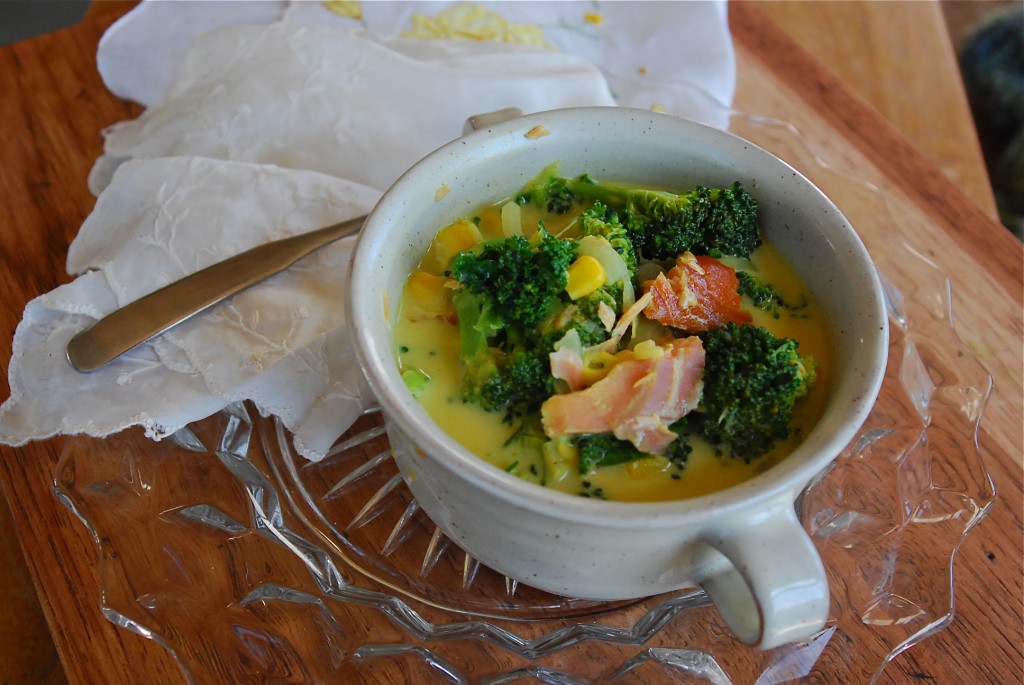
The soup is wide open for your own personal interpretation too, employing just about any vegetable you have on hand. You could skip the smoked salmon if it isn’t to your liking, instead adding maybe some grilled shrimp or scallops for a bit of boldness. The curry is completely adjustable too. Add more for a bigger kick, if you like. Or just substitute turmeric to add the bright and sunny color. While I used broccoli and kale, I think green beans and bok choy would be delicious in this soup. Not a fan of corn? Skip it. Add peas instead. Or chunks of dark orange sweet potato. That’s the best part of this recipe; it’s superbly easy to make it your own.
Curried Vegetable and Smoked Salmon Chowder
Coconut oil for cooking
1 medium red onion, thinly sliced (I’ve used yellow onion too)
1 jalapeno pepper, cored and seeded, thinly sliced (for extra heat, use a serrano)
1 T. minced fresh ginger
2-4 garlic cloves, finely minced (the amount you use is entirely up to your taste)
2 Broccoli crowns, sliced to bite size (can sub in cauliflower)
2 c. fresh kale, roughly chopped (can sub in baby bok choy, chard or spinach too)
1 c. frozen corn kernels
1/2# smoked salmon
2 T. red curry paste (substitute your basic curry powder if it’s all you have)
1 15-oz can light coconut milk
3 c. broth of choice, or water (I filled the coconut milk can twice)
1 T. fish sauce, or fresh squeezed lime juice
1 T. pure honey
Cilantro, basil or mint, fresh lime wedges, crushed peanuts for toppings, if desired
In a medium stockpot with a lid, warm about a tablespoon of the coconut oil and add the onion. Cook, stirring occasionally, until the onion is softened, maybe 10 minutes or so. Add the jalapeno, ginger and garlic and cook for about 5 minutes, stirring. Pour in the coconut milk and broth (or water) and stir together. Then add in the curry paste, fish sauce, and honey and stir well to incorporate, add in the broccoli, kale, and corn. Stir to blend, then bring to a simmer, cover and allow to cook until the broccoli is tender to your liking. Add in the smoked salmon and heat through. Top each soup with some of the fresh herbs, a squeeze of lime juice and chopped peanuts, if you like those. The soup is perfectly fine without them as well.
March 31st, 2012
| 3 Comments »
When I was 15 or 16, my Mom broke her left elbow roller skating. Outside of the fact that my MOM -gasp!- was roller skating (and apparently getting rather cocky about it) she happened to be left-handed, and in breaking her elbow, this rendered her incapable of doing much of anything. She lamented one day, as I helped her in the kitchen, “I wish I had learned to use my right arm more.” and somehow this struck a chord with me, as did her inability to manage even the most mundane of daily tasks.
It’s been in the back of my mind since then to train my hands to work equally. Although my left handed writing looks like an overly caffeinated six year old, and my knife skills in my left hand are nothing compared to my right, I can whisk, scoop, stir, twist, grind, mix and pour from either right or left. I can reach and function and do just about anything needed during the course of my day without having to switch gears, hands or mindset.
There is always more that your body can do, when allowed. If you’ve learned how to type on a standard keyboard, then you can teach your non-dominant hand to do any number of things. Even though one side of our brain dominates, and we develop a set of skills with that dominant hand, there is far more that one is capable of if you’re willing to put your mind to it.
That goes for recipe usage too. Recipes are not cut in stone; they should serve as a guideline, a base from which we can expand exponentially in many different directions. I love recipes because someone else has already done most of the work for me, but I am free to remove this and substitute that, increase this or decrease that or look at how it comes out in one form and think “I know this can be better.” and then trust that my skills can take me there. These skills have been especially useful in the re-development of this incredible Red Rice Pulao.
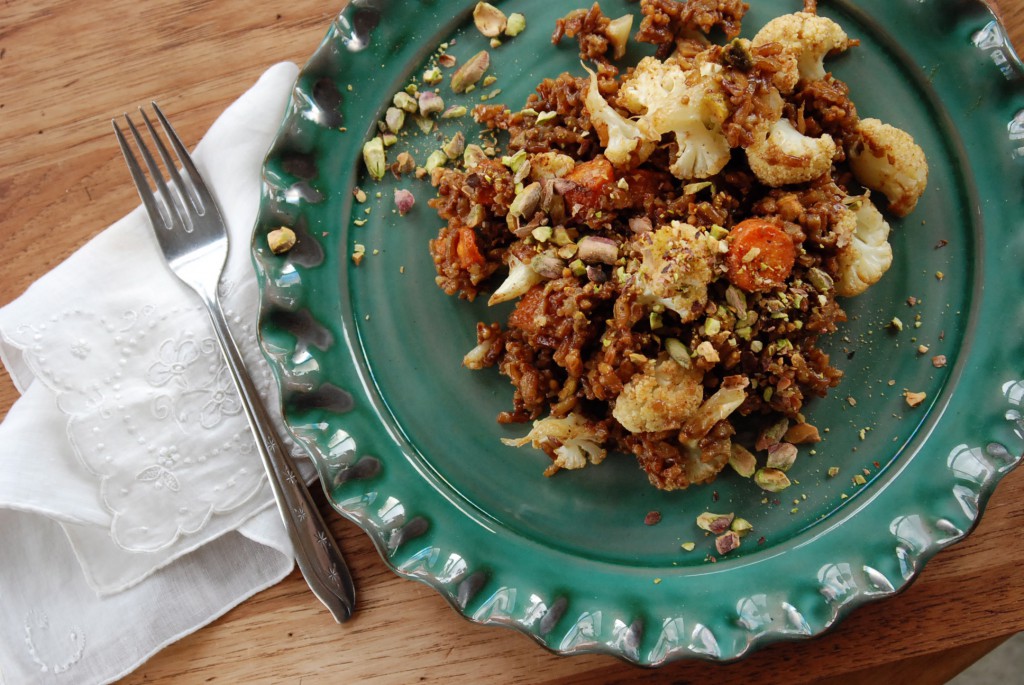
The origin of this recipe comes from Robin Asbell‘s New Whole Grains Cookbook, which, in a soft yet grand way simply changed my life in 2008. Long before the intense embrace by food lovers of all things whole grain, I’d run through a bookful of recipes using quinoa, millet, bulgur and various rices, finding great things to love about these simple staples. Grains are one of the easiest foods to work with in any kitchen, and require no special treatment. Particularly fond of the vibrant rices available, this Red Rice Pulao made for an chewy and delicious experience, and like many wonderful recipes on this blog, I simply posted it once and never went back. What a mistake.
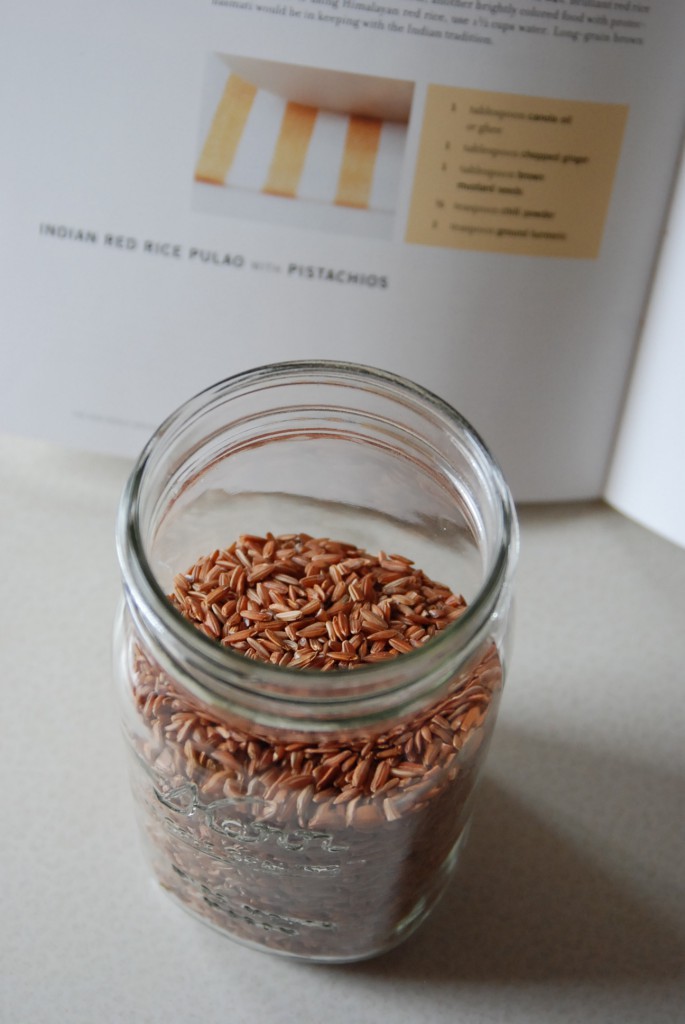
Because that means no one’s ever going to see it, as really, does anyone look in to the archives of a food blog? Rarely. And I loved the recipe when followed to a ‘T’. As I thought about it again, with more capability to be flexible in my cooking, I decided a second go of this dish was in order and am I ever glad I stepped up and made a few changes because this 2.0 version is light years better than the original. No offense to Robin, but the very task of cooking is to learn to feed oneself in the manner that makes you happiest. No cookbook author outside of us knows what makes us happy; only we do, and we owe it to ourselves to learn just enough kitchen skills to take the humblest of foods, such as rice and vegetables, and make them extraordinary. Let the recipe author be your guide, but let your imagination, your tastes and your skills drive you to cook with instinct instead of blind faith.
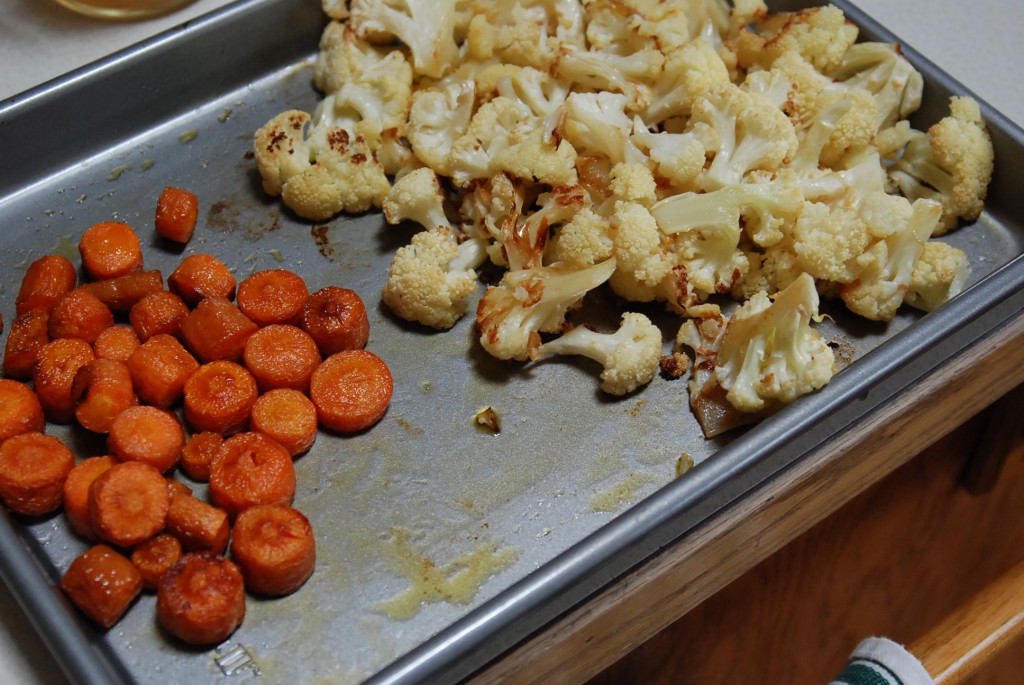
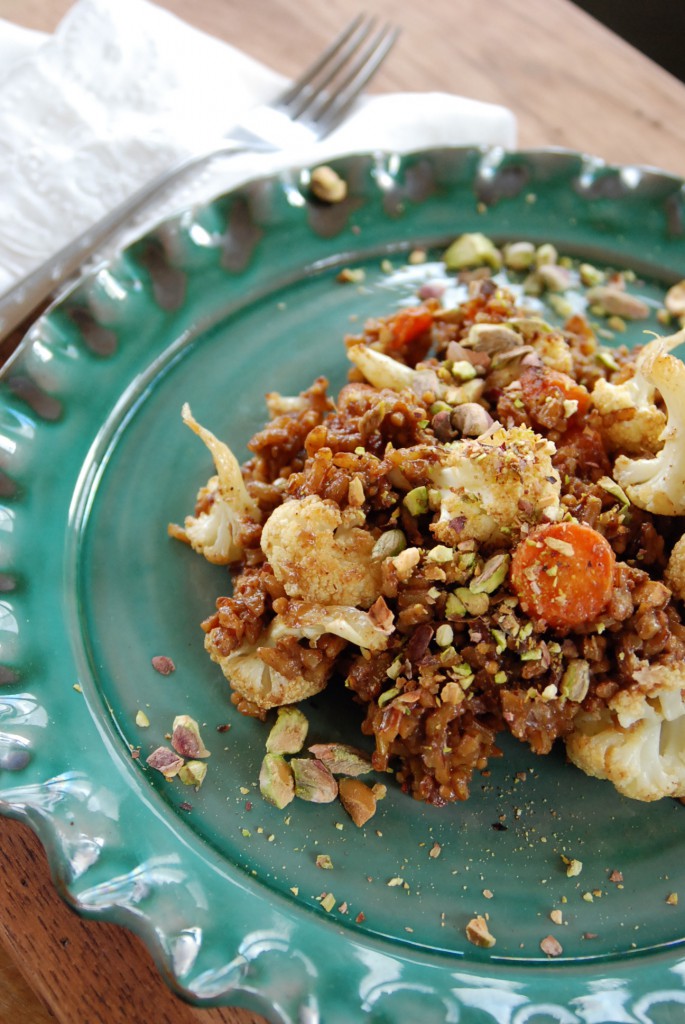
Task-wise, this has a few moments of chopping and prep, but largely you are passing a great deal of idle time as rice simmers, and vegetables roast, while heady fragrances take over your home. This isn’t high-tech stuff here; with the heat of an oven and the magic alchemy of boiling water with rice, you can make an exceptional dish that tastes far more grand than it’s humble beginnings. If you’re unfamiliar with red rice, it’s an intensely chewy rice, often found labeled as Himalayan Red Rice, or Wehani. Properly cooked, it takes up to an hour, all hands off. Finished, it’s a really hearty and satisfying grain, deeper in flavor than brown rice, not as earthy as wild rice. This dish is easily a main course, or can be eaten as a side with any number of proteins. I can vouch that it’s especially good with grilled pork tenderloin.
Here’s where you get to decide what you do with this recipe, because if you want, outside of making the rice you can experiment wildly, with everything else. Instead of carrots and cauliflower, add whatever vegetables you have on hand, or swap almonds, walnuts, pecans or peanuts for the pistachios. This is your base, and when you read through it, your tastes will direct you, just as they should. Trust those instincts. And enjoy.
Red Rice Pulao with Roasted Vegetables
1 T. oil of choice
1 T. chopped ginger
1 T. brown mustard seeds
1 shallot, finely chopped
1/2 t. chili powder
1 t. ground turmeric
1 c. red rice or brown basmati rice
2 c. water
1 T. brown sugar
1 t. salt
2 T. lemon juice
1 head of cauliflower, cut to bite sized pieces
2 medium carrots, sliced
1/2 c. shelled pistachios or toasted slivered almonds
In a 2-qt saucepan, heat oil briefly and add ginger, mustard seed and shallot. Cook for a few minutes, until the ginger is fragrant and the seeds are popping slightly, then add chili powder and turmeric. Stir it up well and cook for a few seconds until the smell is amazing. Add rice, water, brown sugar and salt, stir it up good to combine it all and bring to a boil. Cover tightly, reduce heat to low. The amount of time needed to cook the rice will depend on what rice you use. Test the grains after the time specified on the package, and adjust to your personal taste. Allow to cool slightly. If you are using a true red rice, be patient with it. The time required for me to make mine was slightly over an hour. And every minute was well worth it.
While the rice cooks, heat the oven to 400°, and toss the vegetables with a bit of oil and salt. Since these two cook differently, I put the cauliflower on one pan, the carrots on another and roast until each are tender, shaking the pan often, and stirring to insure even browning. They can hang out in their finished state, until the rice is done.
If you love a good deep flavor for pistachios, take a few minutes and toast them in a skillet over medium heat. It’s well worth it, and that rice gives you plenty of time.
When the rice is done and cooled, dump it all in a large bowl and add the roasted vegetables. Toss together gently and add a few tablespoons of those nicely toasted pistachios. Toss a bit more, taste and add salt and pepper if you wish, then serve it, topped with more pistachios. This dish is good whether served cold, hot or at room temperature. You can garnish it with chopped scallions too, for a bit more flavor.
March 24th, 2012
| 3 Comments »
Long ago, through some rather perfect serendipity, I came across this recipe (method, really) in both a cookbook I happened to pick up for browsing in a bookstore, and again, in an New York Times article just about the same day. Both times, reading of softly boiled red potatoes topped with briny tapenade, my mouth did that sort of happy dance that one gets when a food is particularly appealing. I made them. Once. And then, every time I see tiny little red potatoes I think ‘Why have I not repeated that dish?’
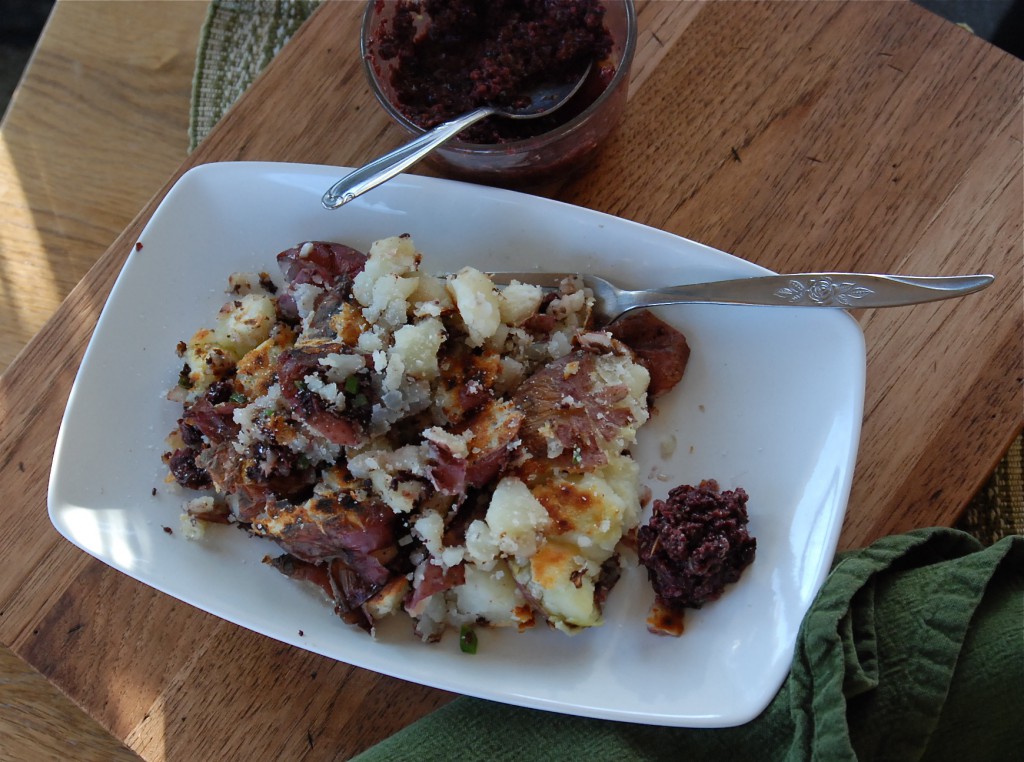
I don’t have much of an excuse, really. And it isn’t that it’s even that difficult. You can use prepared tapenade, instead of making your own and you’ve got half the battle done, right there. And really, does boiling little red potatoes take up SO much of my time? Who am I?
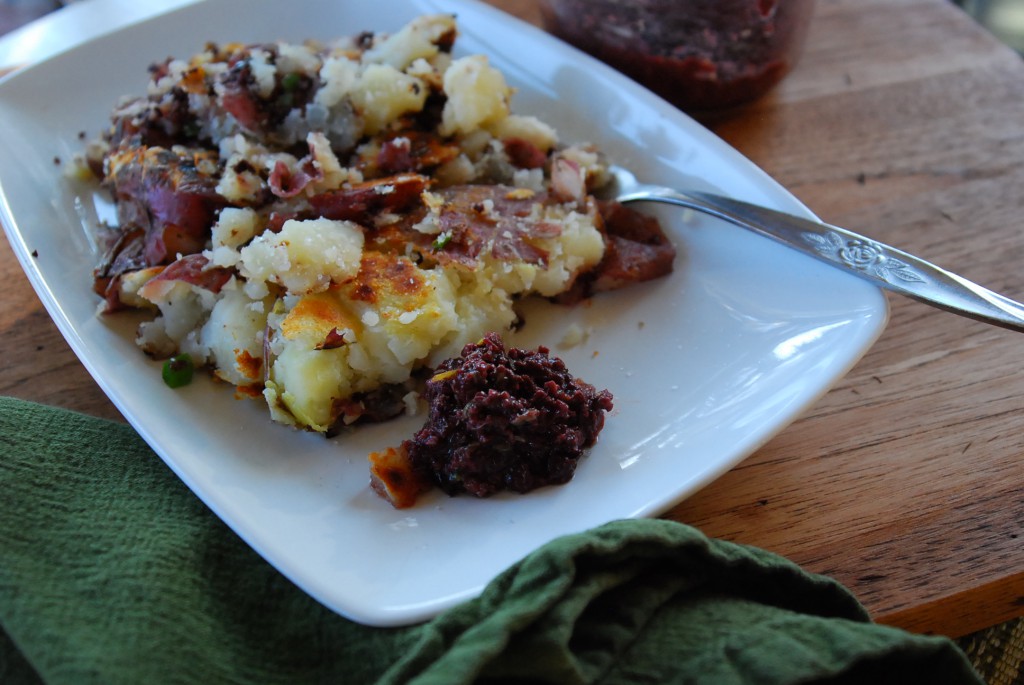
The flavors marry in the most unusual way. Soft and simple, a boiled potato isn’t a whole lot all on it’s own; it needs a friend to help wake it up, make someone take notice. That’s the tapenade’s job. It’s a loudmouth, all right. Sharp, briny and out there, it sidles up next to the humble boiled potato and says ‘Hey, let’s make some noise’ and pretty soon, with the addition of half a jalapeno pepper languishing in the fridge, and a shallot for good measure (potatoes and onions are so utterly complimentary) you’ve got yourself a plate of something that’s risen to greater gustatory heights. It’s humble and basic, still. But fantastically more. It’s the type of dish that soothes the rough spots out of your week, gives you pause. A forkful raised to your mouth is at once sharp and fragrant, then through the bite of olive, lemon and caper, soft in the way only a perfectly boiled potato can be.
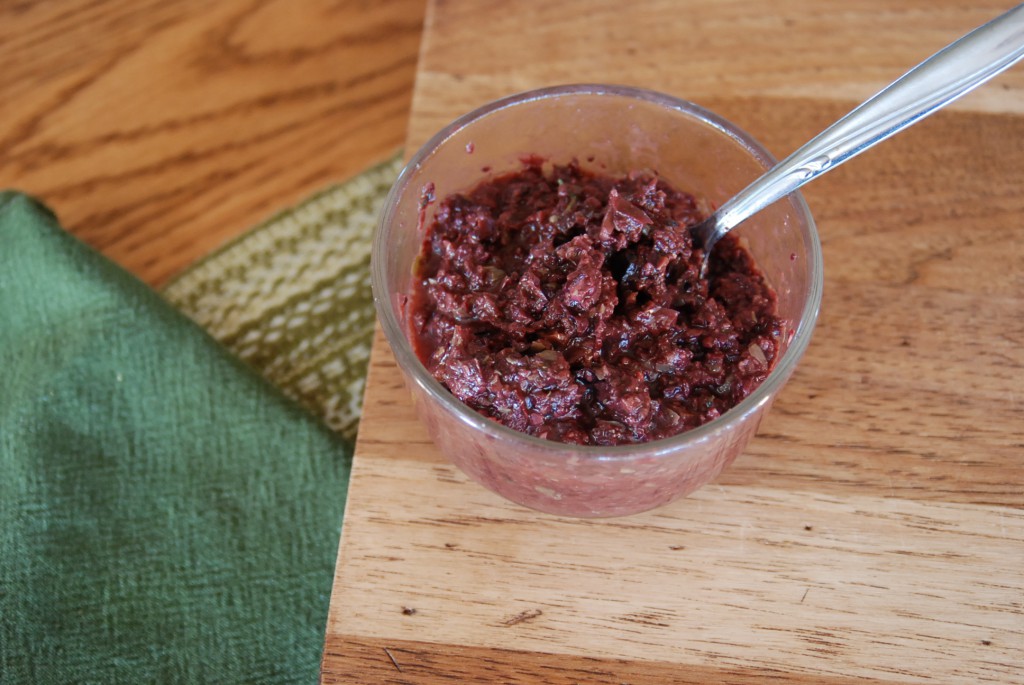
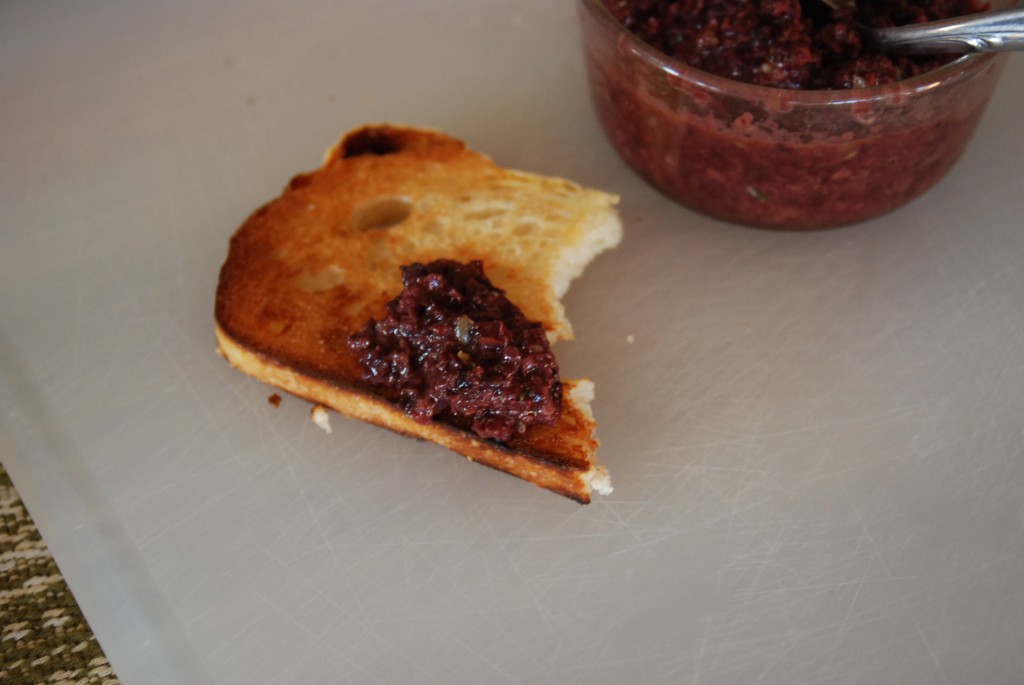
Best part about making this simple and humble dish is that you’re likely to have leftover tapenade, and spreading that on a bit of toasted bread is one of my most memorable treats. In fact, eyeing the simmering pot of potatoes while I scooped tapenade on freshly toasted asiago cheese bread, I quickly calculated the merits of actually finishing the recipe, versus sitting down with the remains of the bread and the tiny dish of olive spread, but soon realized how boring that would sound. I’d had enough of boring, and it was time to make a little noise.
Smashed Potatoes and Olive Tapenade
For the Tapenade:
1 c. kalamata olives, minced
2 T. capers, minced
1 t. grated lemon zest
1 T. fresh lemon juice
1 1/2 t. fresh thyme, chopped
1/2 c. extra virgin olive oil
Fresh ground black pepper
Mix everything together in a bowl and allow to stand for a while to blend. You can whiz everything in a food processor to make it easier. Don’t skip the lemon zest and juice. It’s delightful in this.
For the Potatoes:
About 1-1/2 pounds of waxy small red or white potatoes,
2 T. red wine vinegar
1 bay leaf
6 black peppercorns
Salt
Wash potatoes. If not uniform in size, cut to size and boil, with all added seasonings, until tender. Drain and discard seasonings. Allow the potatoes to cool slightly, then gently crush them with your palm so they break open, but don’t bust them apart too much.
Heat a heavy skillet over medium-high heat. Cast iron works beautifully for this. Add a small amount of butter and oil and swirl to coat the pan. When hot, place potatoes in a single layer in the pan. You may not use all of them. Cook for 10 minutes or so, until a good crust forms on the bottom. Dot the top with about 1/4 cup of the tapenade, and carefully turn the potatoes over. Allow to cook on the other side for an additional 5-10 minutes. Serve with tapenade on the side.
NOTE: You can add a finely minced shallot and jalapeno at the same time you add the tapenade. These added a nice dimension of flavor to the finished dish.
Original recipe: “Seven Fires: Grilling the Argentine Way” by Francis Mallman and Peter Kaminsky (via the New York Times Dining Section, 5/20/09)
March 4th, 2012
| 1 Comment »
This time of year is a hard one.

I seem to start slipping off the tightrope each February. Bored, restless, tired and too stunted by the dull landscape, I stand on the figurative ledge and think ‘Ugh.’ as I look around. The vertigo makes me twitchy, and thankfully, a trusted friend is there to pull me back and say ‘You know, you go through this every year at this time.’. I’m grateful for someone standing outside of me, who can rationalize this wandering mind, drawing it back to the reality that it’s just late winter and I could use some green and some color in my life.



Surrounding myself with a few hours of plant life, of colorful flowers, weeping ferns and a warmth that left me sweaty certainly helped a great deal, and it seems to become more important in the last gasp of winter to put sunny, warm foods in to the body, like an infusion of heat and sunshine that lights us up from the inside. Like this lemony pasta.
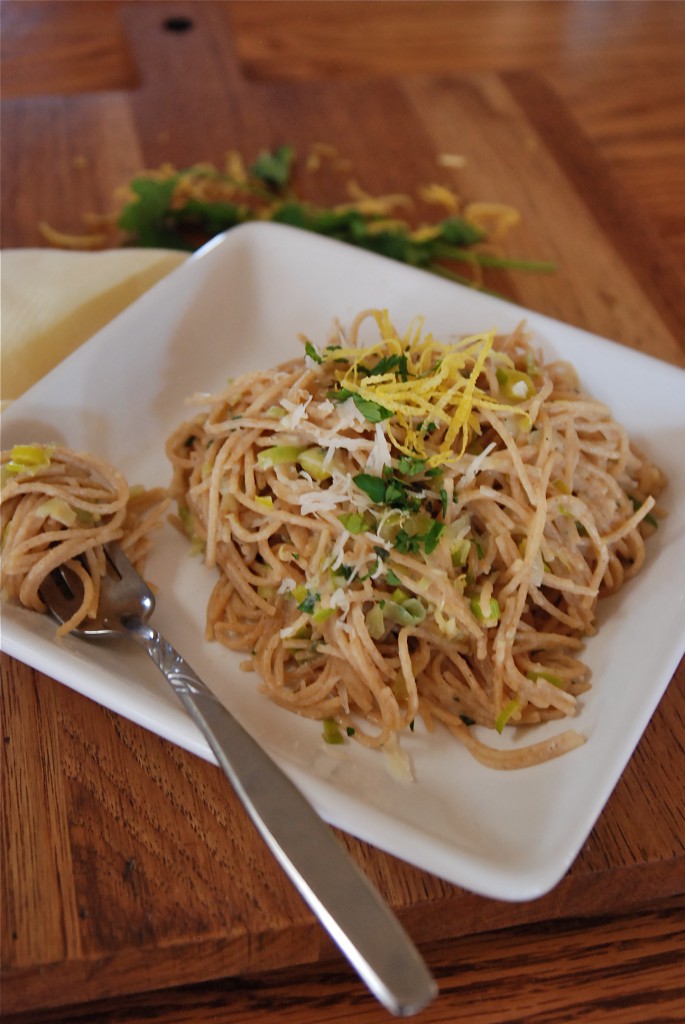
Eating anything with lemon in it is like ingesting sunshine, it’s so bright and engaging. This couldn’t be simpler to make, with a few leeks, a juicy lemon and a shower of fresh herbs, and parmesan cheese. I’ve done so much with lemons in my baking, like this Lemon Pound Cake, these intense Lemongrass Bars, and a delicious Lemon Ricotta Cookie, but adding sparkling citrus flavor to savory dishes has been few and far between, with maybe the exception of these exceptional Garlicky Lemon White Beans. That’s to an end though, after discovering this bright and lively pasta dish.
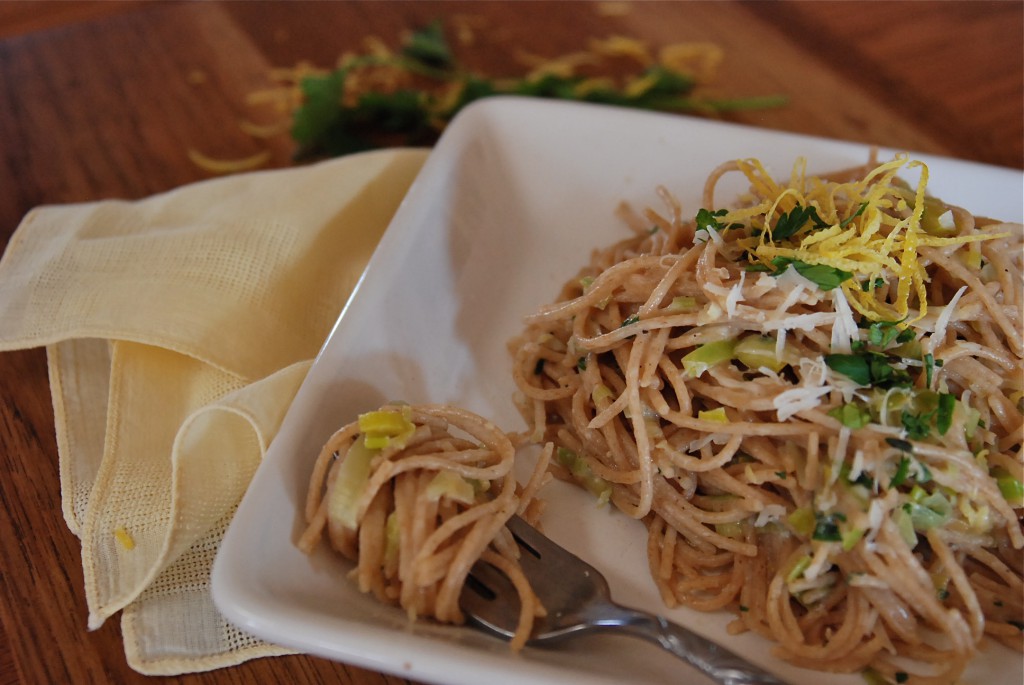
From the February issue of Eating Well magazine, resplendent with juicy lemon slices on it’s cover, this is a quick and easy recipe to put together. In the time it takes you to make a pot of pasta, you can have the leeks sauteed, ready and waiting. A few turns in the pan, with a splash of that ever-important pasta water and dinner is served.
Leek and Lemon Pasta
1# whole-wheat linguine or thin spaghetti
2 large lemons, plus lemon wedges for garnish
2 medium leeks (white and pale green parts only), thinly sliced and rinsed well
2 tablespoon extra-virgin olive oil
1/2 cup chopped flat-leaf parsley, divided
2 cloves garlic, crushed
1/4 teaspoon salt
1/8 teaspoon freshly ground pepper
3/4 cup finely grated Parmesan cheese, divided
1/4 cup snipped fresh chives, divided (I used thyme and it was delicious)
Cook pasta in a large pot of boiling water until just tender or according to package directions. Reserve 1-1/2 cups of the cooking liquid and drain the pasta in a colander.
Meanwhile, finely grate the zest from one lemon and squeeze juice from both lemons; set the juice aside. Pat leek slices dry. Heat oil in a large nonstick skillet over medium-high heat. Add the leek, the lemon zest, 1/4 cup parsley, garlic, salt and pepper. Cook, stirring frequently, until the leek is lightly browned and softened, about 6 minutes.
Add the pasta, 1 cup of the reserved cooking liquid, 1/4 cup of the lemon juice and the remaining 1/4 cup parsley to the pan. Cook, stirring constantly, until the liquid is mostly absorbed, 30 seconds to 1 minute. Add the remaining 1/2 cup liquid, or more lemon juice, if desired. Remove from the heat. Toss the pasta with 1/4 cup Parmesan and 2 tablespoons chives. Transfer to a serving bowl or bowls; sprinkle with the remaining Parmesan and 2 tablespoons chives and serve with lemon wedges, if desired.
Recipe in full, from Eating Well magazine, February 2012.
RECIPE NOTES: A simple reminder to yourself to catch the pasta water when draining it is to place a pyrex measuring cup in the bottom of your strainer when you put it in the sink. Pour some of the pasta water in it, set it aside, then drain the pasta completely. Another method, which I prefer, is to remove the cooked pasta from the water with tongs and add it directly to the skillet. It takes a bit of timing to get it right, but instead of draining all that beneficial starch away, it clings to the pasta and helps to create the pan sauce needed.
This dish would be wonderful with a broiled mild fish, such as Cod or Tilapia, some seared Scallops or Shrimp would also taste good. If you like chicken, a good lemon-herb rub and a run under the broiler would make a perfect accompaniment to this pasta.
February 5th, 2012
| 4 Comments »
This post could also be aptly titled “The end of searching for the perfect banana bread” but that just seemed too long and a bit too final. I should never think I’ve ‘arrived’ at any destination, be it a quest for knowledge, a higher level of health and well-being or never-ending search for perfect banana bread, as somewhere out there, a recipe may exist that could bring this loaf to shame, but for now, I’m sticking with what I’ve got.

I grew up eating banana bread, from the earliest memories that I have. My Mom made it almost weekly, in fact, I’m pretty sure she bought way more bananas than she needed just so she’d have an excuse. She put walnuts in it, which I despised, so these days, my banana bread is always without nuts. When I got old enough to make my own banana bread, I turned to her tried and true recipe from my youth, and as an adult, I found it sorely lacking, so I moved on. And on. And on.
The goal that I’ve strived for, over recipes and time and growing older, was pure banana bread bliss and perfection that existed as a mental taste somewhere in my mind. And with the first bite of this grain-studded loaf, rich with banana flavor, I about leapt in the air with delight, shouting ‘Eureka!! I have found it!’ while my son chuckled in delight at my antics, he himself wide-eyed and excited over the taste of his piece. This IS pure banana bread delight, and I don’t say that lightly. Folks, I have made and eaten A LOT of banana breads in my lifetime, as I sought out that elusive fine balance of moist and tender crumb, ultimate banana taste and now, a higher level of health than a loaf crushing the scales with sugar and fat. After researching low-fat, and healthier banana bread options for over an hour, I settled on one recipe that gave me a pretty good start, and then started tweaking it to my liking.
I think my biggest disappointment with banana bread has always been that it just doesn’t have as much banana flavor as I want. I add more banana to any number of recipes, and I get mushy bread that turns soggy after a few days, so clearly, without some changes to the base, that’s not a workable option. And I needed a substantial heft other than what flour and leavening can offer in order to stand against that large dose of delicious bananas. When making muffins, I’ve turned to the use of cereals and grains to add more heft, and to make them a bit more nutritious. When faced with adjusting a banana bread recipe in the same way, that’s where I went as well. This recipe has whole rolled oats, All-Bran cereal and a commercial 10-grain cereal as a majority of the dry base. Cutting back on the use of eggs, I added some ground flaxseed for binder (you could also use unsweetened applesauce for this as well). The ricotta cheese, along with a small amount of milk, provides a richness in the texture that’s particularly pleasing to the mouth. The sugar was another matter; I took a gamble, using only a mere half cup in a recipe that makes two loaves. Most tea-bread recipes that I come across have, at least in my opinion, way, way too much sugar, and this amount was perfect. The end result is a bread without the teeth clenching sweetness, so the rich banana flavor just shines through. The cereal and grain base makes the texture nubbly and firm, and helps it retain a lot of moisture. Best of all, the loaves are simply packed with banana flavor.
A lot of this was pure kitchen chemistry, mixed with a lifetime of learning why the recipes I tried were so disappointing. After so many experiments, it’s nice to finally land on something that lifts your heart and elevates your taste-buds, all the while being reasonably healthy enough to enjoy without much guilt.
If you’re like me, when bananas get past the point of consumption in your house, they get tossed in the freezer to await a baking urge, and this recipe is perfect for when you’ve gotten a large stockpile of them.
Whole Grain Banana Ricotta Bread
Yield: Two loaves. It can easily be cut in half.
Preheat the oven to 350°. Spray two 9×5 standard loaf pans with cooking spray.
In a large bowl, mix together the following:
6 large, very ripe bananas, mashed
3/4 c. ricotta cheese
1/3 c. milk of choice
1/2 c. sugar
3 T. grape-seed oil (or other neutral flavored oil)
1 t. pure vanilla extract
1 egg
2 T. ground flaxseed
1/2 c. whole rolled oats
1/2 c. All-Bran cereal
1/2 c. commercial 10-grain cereal, such as Bob’s Red Mill (sub 7-Grain, or 5-Grain if you can only find those)
Whisk this until well blended and allow to sit for about 15 minutes to soften the grains.
In a large measuring cup, combine the following:
2 c. whole wheat flour
1 c. unbleached AP flour
1 t. sea salt
1-1/2 t. baking soda
2 t. baking powder
Add the dry ingredients to the bowl with the banana mixture, and with a rubber spatula, gently fold them together until all the dry ingredients are incorporated. Be careful not to overmix. The batter will be very thick.
Divide the batter between the two loaf pans and smooth the top. Drop the pans on the counter a few times to settle the batter and release any air pockets. Bake for 50-60 minutes, or until a toothpick inserted in the center comes out clean. Allow loaves to cool in pan for up to a half hour before turning them out to cool completely on a rack.
RECIPE NOTES: I use All-Bran cereal a lot in baking, and it keeps a long time in your cupboard. Bob’s Red Mill 10-grain cereal is not only a delicious breakfast cereal, but it’s wonderful for breads too, and I’ve also used it in muffins. I keep it in a plastic bag in the freezer and it lasts indefinitely. I also keep a baggie of ground flaxseed in the freezer.
If all you have on hand is whole rolled oats, this recipe would work just fine to use those in the full amount.
If you wish to cut the recipe in half, don’t use the flaxseed, as it acts as a second ‘egg’.
January 27th, 2012
| 4 Comments »
January is drawing to a close and we’ve only just now received the first good snowfall to completely cover the landscape. And with only one brief cold snap, where temperatures dropped below zero for a day or two, it really just hasn’t felt much like winter at all. Still, the calendar doesn’t lie, the light still falls off before the dinner hour -although it gets later and later every day!!- and the hum of an oven, concealing something aromatic and delicious is still welcomed in any Minnesota home.
Lemon is everywhere right now. Those bright yellow orbs are certainly popular in the wintertime, bursting forth with that incredible fresh scent. Lemon is like sunshine, and not just from the sunny yellow color; that spritz of luscious lemony aroma that bursts from the rind when you cut into it is a wonderful tonic to the drab and gray of a winter day. I even feel sunnier eating lemon, like the light rays are just pouring through me. And citrus fruits are coming to the cold, lifeless mid-section of the country in all forms; gigantic globes of grapefruit, sunny tangerines, adorable little kumquats and key limes plus endless lemons.
I love to bake with lemon anything, and I particularly love the fresh zest paired with blueberries. But I have to admit that a lemon pound cake can make my knees weak. There is something about that tart bite, and the dense moist crumb that gets me, that makes it irresistible. But I’m not such a huge fan of the calories in pound cake, so finding a recipe that makes a lighter and less caloric version made me eager to try it out. But I had to ask myself…. would this even be worth it? We’ve all had those experiences of finding a less decadent way of baking a prized cake that simply falls flat. I couldn’t stand to be faced with a lemon cake that left me wanting more.
Needless to say, I was not at all disappointed.
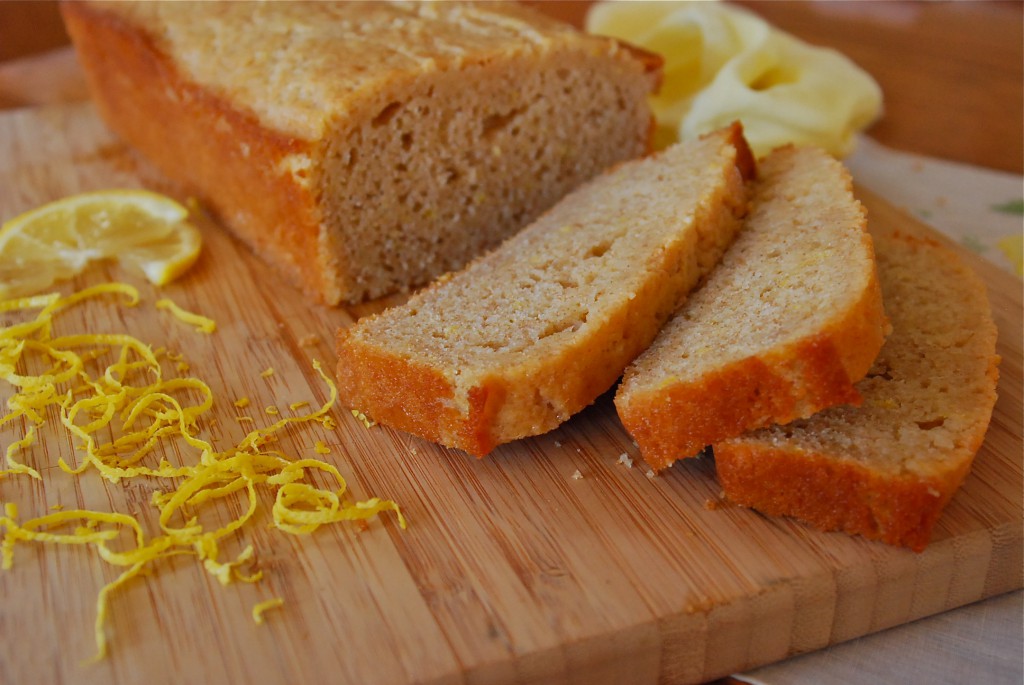
If you didn’t know that this cake wasn’t made with a ton of butter and sugar, you might not realize it at all. It still has that gloriously dense texture that’s rich and satisfying. It still shouts “LEMON!!” with every bite. It satisfies and satiates and makes for a luxurious treat that doesn’t leave you feeling too guilty. There’s a ‘just tart enough’ glaze brushed over the top of it to add even more of that lovely mouth-puckering taste, making the top of the cake nice and soft too, something I love about a good teacake.
The bright and sunny winter day even made the photos look like they were bathed in lemony light.
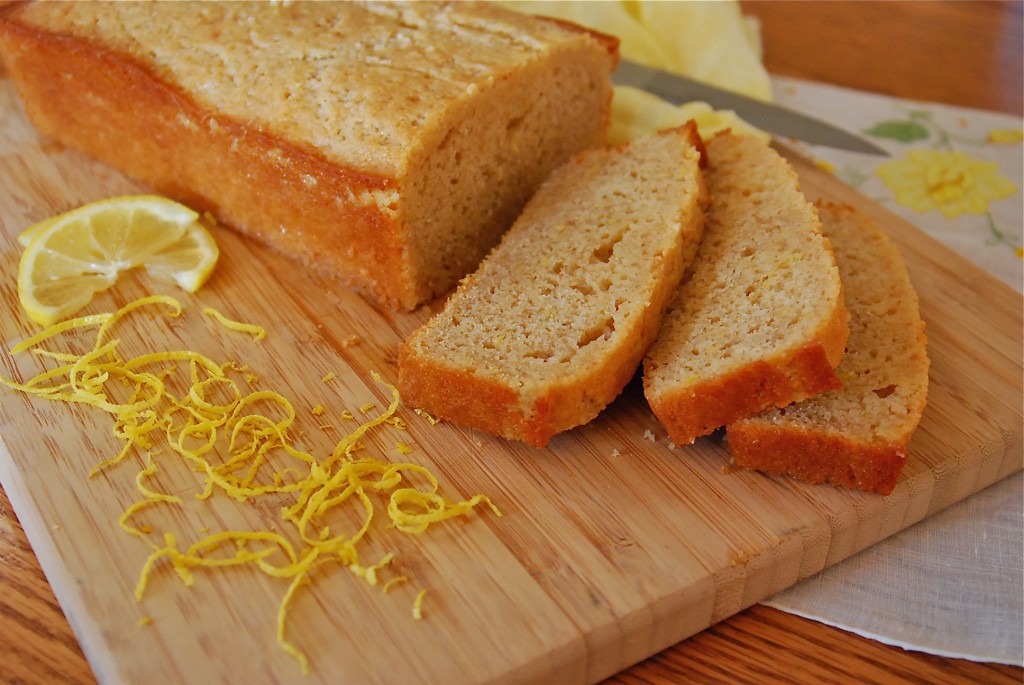
Lemon Pound Cake
- 1 cup whole-wheat pastry flour or white whole-wheat flour
- 3/4 cup all-purpose flour
- 2 teaspoons baking powder
- 1/4 teaspoon salt
- 3 large lemons, divided
- 1 1/4 cups sugar, divided
- 3 ounces reduced-fat cream cheese (Neufchâtel), at room temperature
- 2 tablespoons butter, at room temperature
- 3 large egg whites, at room temperature (see Tips)
- 1 large egg, at room temperature
- 1/2 cup reduced-fat milk
Preheat oven to 350°F. Coat a 9-by-5-inch (or similar-size) loaf pan with cooking spray; dust with flour and tap out any excess.Sift whole-wheat flour, all-purpose flour, baking powder and salt together into a medium bowl.
Finely grate 2 tablespoons zest from 2 of the lemons; set the lemons aside. Beat 3/4 cup sugar, cream cheese, butter and the zest in a large bowl with an electric mixer on medium-high speed until light and fluffy, about 2 minutes. Beat in egg whites, one at a time, beating well after each addition. Add the egg and beat well. Reduce speed to medium and beat in milk; the mixture will look curdled.
Reduce the mixer speed to low and add the flour mixture in 2 batches, beating just until combined and scraping down the sides of the bowl as necessary. Transfer the batter to the prepared pan and smooth the top with a rubber spatula.
Bake the cake until a wooden skewer inserted in the center comes out clean, 45 to 50 minutes. Cool in the pan on a wire rack for 15 minutes. Run a knife around the sides and turn the cake out onto the rack.
While the cake is cooling, squeeze 5 tablespoons juice from the zested lemons. Trim the ends off the remaining whole lemon and very thinly slice; discard any seeds. Heat the lemon juice and remaining 1/2 cup sugar in a small nonstick skillet over medium heat, stirring until the sugar is dissolved. Add the lemon slices and cook, stirring frequently, until softened, about 5 minutes. Reduce heat to maintain a simmer. Use a fork to transfer the lemon slices to a bowl. Continue simmering the syrup until slightly thickened and beginning to turn golden yellow, 2 to 4 minutes
Set the rack over a rimmed baking sheet. Poke holes all over the top of the warm cake with a wooden skewer, 1 1/2 to 2 inches deep. Spoon the glaze over the cake, poking more holes if the glaze does not sink in. Arrange the lemon slices on top. Let the cake cool completely before slicing.
Recipe Notes: I made my cake with the glaze, and not the candied lemon slices. I tried, but they fell apart in the syrup and looked strange so I didn’t put them on the cake. The glaze was good, but I think the cake doesn’t really need it either.
Recipe from Eating Well magazine, posted in original form.
January 18th, 2012
| 7 Comments »
I did not grow up loving mushrooms. I didn’t even like them, not one little bit. But I surely can’t blame myself, for my only exposure to them as a child of the ’70’s was from a can. And I can’t imagine anything more disgusting than canned mushrooms to a kid. No wonder I was never a fan of the fungus.
As I got older, I allowed a bit of mushroom to pass my lips; I loved them sauteed on a burger, or with a grilled steak. Provided I could have something in my mouth with them, they became only slightly more palatable to me, but I still struggled with texture, and that rich, loamy earthiness to them. Cover them with good red wine, and sauté them in copious amounts of butter and it was ok. Just ok though. Still, they weren’t on my favorites list by any means.
Then I had an epiphany, last summer. A major turning point in my culinary taste occurred at one of the wonderful events I attended last year with the Minnesota Food Bloggers group. It was at Cafe Levain in Minneapolis, and Chef Adam Vickerman created grilled portabella mushrooms, richly glazed in balsamic vinegar. I took a few tentative bites of them and my eyes were opened. I was re-born, re-newed and suddenly, all-out crazy for mushrooms. And to Adam’s credit, I’ve been slightly obsessed, and eating them weekly, ever since.
Mushrooms fit well into a healthy eating plan, and that makes them far more desirable given my all-enveloping obsession. Mushrooms have been revered in Eastern culture for thousands of years for their nutritional properties. Mushrooms are low in calories, fat-free, cholesterol-free and very low in sodium, yet they provide important nutrients, including minerals like selenium, potassium, copper, and vitamins such as riboflavin, niacin (the all important B vitamins) and vitamin D. And then there’s beta-glucans- something I’d never heard of before, and according to Mushroom Info:
“Beta-glucans, found in numerous mushroom species, have shown marked immunity-stimulating effects, contribute to resistance against allergies and may also participate in physiological processes related to the metabolism of fats and sugars in the human body. The beta-glucans contained in oyster, shiitake and split gill mushrooms are considered to be the most effective.”
So I can feel good about the amount of mushrooms passing my lips, and I like that. I can incorporate mushrooms in to just about any dish, but I hadn’t really done much with them in a soup so it was fun to come across this amazing Wild Rice & Mushroom soup recipe on The Kitchn, even better that I stumbled upon it as the coldest air of the month landed on Minnesota, making for a perfect backdrop to a steaming bowl of this thick and hearty soup.
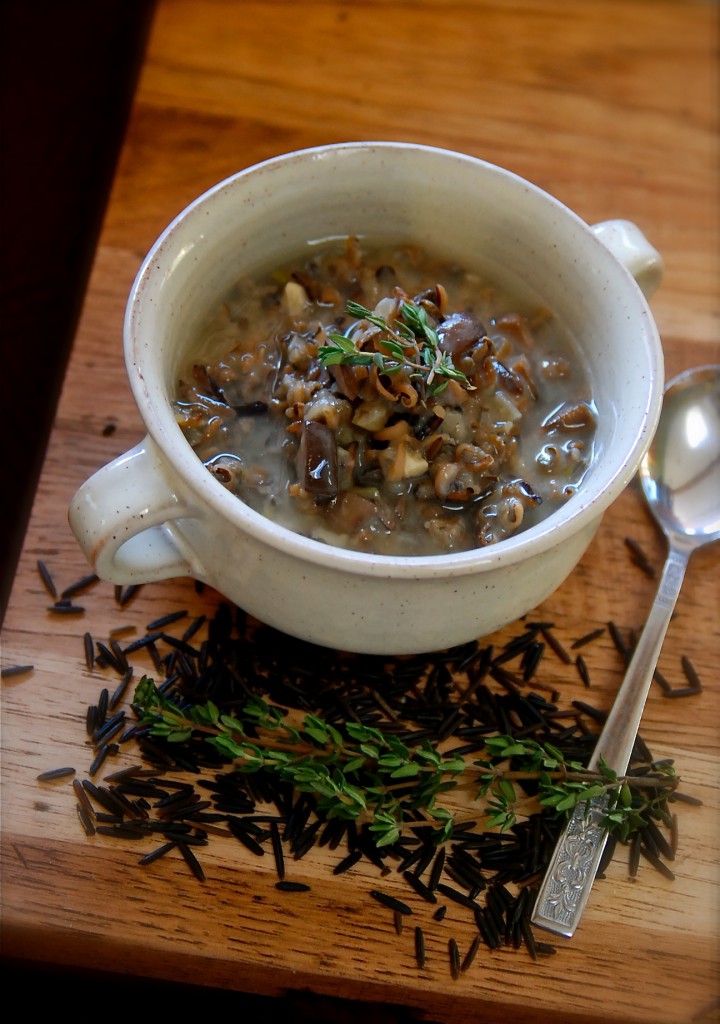
If you love a good wild rice soup with chicken, or turkey, you’ll love this lush recipe, which deeply browns mushrooms to develop their rich flavor. A bath of white wine and some good vegetable broth helps round out the simple but complex flavors. Wild rice was another food item I had to learn how to love, but thankfully, this wasn’t that difficult, and we’ve been enjoying wild rice soups for years. This one, with it deep earthy flavors and thick broth will be on repeat now. We all loved it, and soup is such a good leftover item to have on hand.
Wild Rice and Mushroom Soup
1 c. wild rice, washed
1 large onion, diced
4 celery stalks, diced (I love the flavor of the leaves and used a lot of those)
2 cloves garlic, minced
1 pound of mushrooms, rough chopped (I used baby portabella, but adding some porcini or oyster would be delicious)
1 t. fresh thyme
3 T. AP flour
1 c. white wine (I use pinot grigio in cooking. DO NOT use cooking wine from the grocer. Ugh)
1 Bay leaf
1-2 cheese rinds, optional
2 t. fresh rosemary, chopped
1 c. whole milk or heavy cream (I used a lot less, but adjust according to your taste)
1 T. cider vinegar
Salt and fresh ground pepper
Bring a pot of water to a boil and add the rice with 1 teaspoon of salt. Reduce to a simmer and cook for 40-50 minutes, or until the rice has burst open and is soft. You can leave it a bit underdone if you wish, and cook it to taste with the final soup. Drain the rice, reserving the cooking water to use in the soup if you wish. (I did this. Wow. What a flavor)
Meanwhile, heat a teaspoon of oil in a large dutch oven or stock pot over medium-high heat. Add the onions and celery with a pinch of salt and cook until softened and translucent, about 5-7 minutes. Turn the heat down to medium and add the mushrooms and another pinch of salt. Cook until the mushrooms have released their liquid and start to brown; this should take anywhere from 20-40 minutes depending on the size of your stock pot. I cooked them to a really deep brown. Don’t skip this step as this is where a lot of the flavor of your soup will come from.
Once they are nicely browned, add the garlic and thyme and cook for about a minute. Sprinkle the flour over the vegetables and stir to coat. Stir the flour until the mixture becomes sticky, and no visible dry flour remains. Increase the heat to medium-high and add the white wine. Stir and scrape the bottom of the pan, simmering until the wine has reduced and thickened.
Add the bay leaf, cheese rinds (if using) and stock or the cooking water from the rice. Bring to a boil, then reduce and simmer for about 20 minutes to blend the flavors. Add the rosemary, milk or cream and the wild rice, cooking for another 10-15 minutes, or until the soup has thickened to your liking. Stir in the cider vinegar, season with salt and pepper to taste.
Original recipe from The Kitchn, by Emma Christenson.
***This soup will thicken as it stands, and the rice absorbs more of the liquid. I’ve found that when re-heating it the next day, it tastes best to scoop out a serving and add water to loosen it up.
Linking up to Soupapalooza 2012!!
“Come join SoupaPalooza at TidyMom and Dine and Dishsponsored by KitchenAid, Red Star Yeast and Le Creuset”
January 5th, 2012
| 4 Comments »
The new year is starting out with a bit less motivation than I was expecting. This isn’t such a bad thing; I did have the last five days off work, and after the busy, frenetic pace of the holidays that was a very welcome change. Maybe the sloth that settled on me was just a reminder to take the time off wisely, to relax, regenerate and just be.
But I wanted to cook and I wanted to stretch. I’ve been lacking in the desire to stretch in the kitchen, to experiment with a few recipes that press against the norm of what I’ve been doing lately, which admittedly, isn’t a whole lot. That work thing sort of stunted my creativity for a while, and before that…. well, I was just coasting. But we’re on a fresh calendar page, with new beginnings for everyone; resolves to take a healthier approach to life, to strive for better in our personal lives; I’ve even seen people who are eager to expand their eating repertoire, promising to try one new food item each week. These are resolves I can get behind. And along with continuing on our meat-free journey, I need to explore more options for our meals. Because while soups, meatless chili and braised greens are all tremendous and satisfying, there is so much more in this vegetable world that can be taken on.
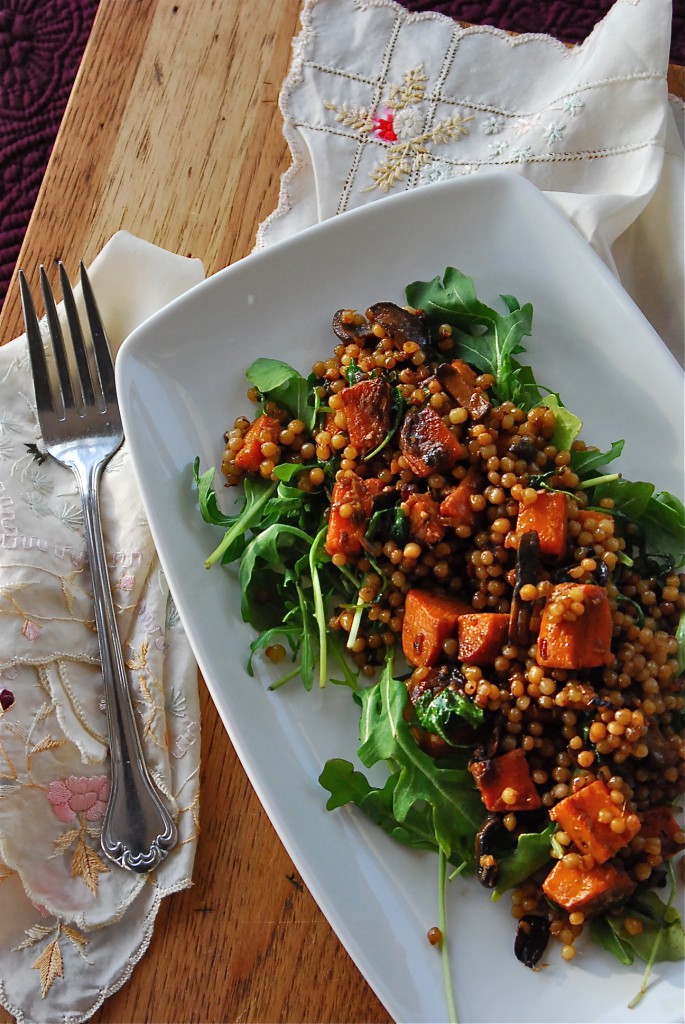
This recipe was bookmarked back in October, most likely. As is the norm, I’m just not sure why I don’t tackle these things as soon as they land in my radar. I could have been enjoying this dish on repeat each week, changing up the vegetables and inhaling it’s deeply dark and sweet flavor through these last few months, but as usual, it languished. And we missed out. That’s too bad. The flavor in this dish was incredible, invading our senses not only as it cooked, but as we gathered over our steaming bowls, forks poised in anticipation. I looked down at my bowl and turned to Mike. “This is a total restaurant dish.” and he nodded as the first bite crossed his lips. His eyes lit up and he smiled.
And there’s another reason why I kick myself for waiting so long to enjoy this. To miss out on seeing that is criminal.
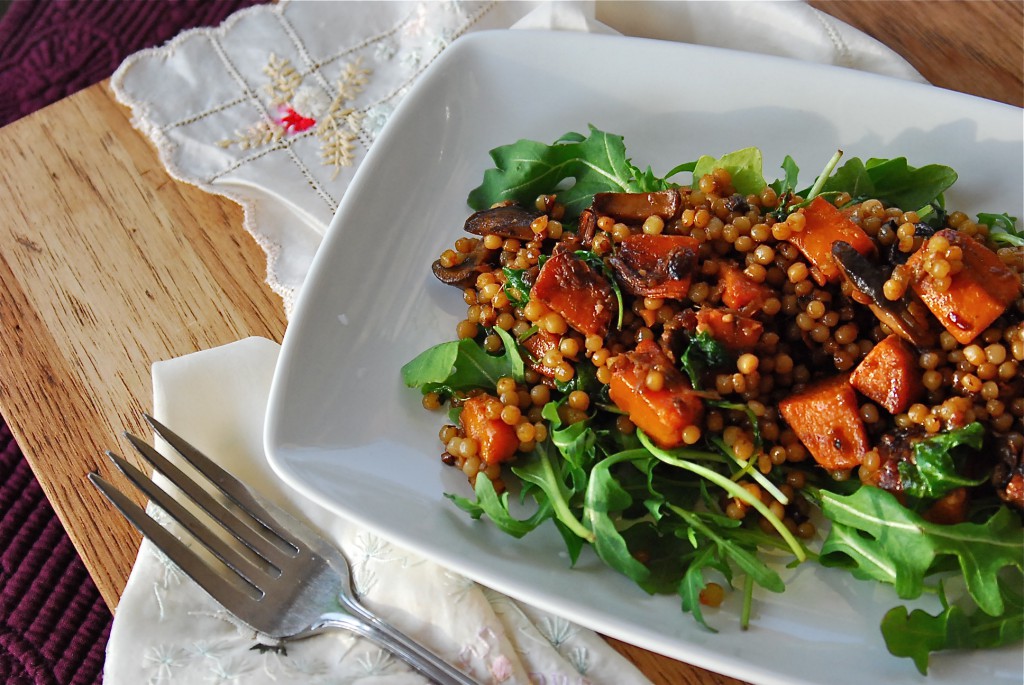
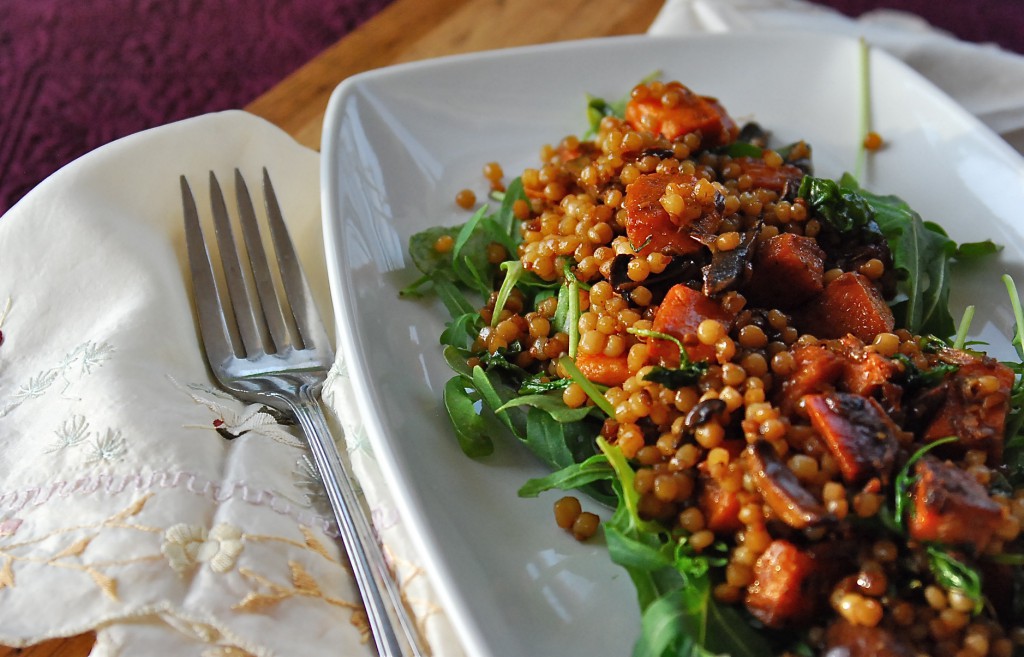
The creation of this dish isn’t difficult; it does require some attention as you methodically caramelize your vegetables in stages on the stovetop. I evolved the process from the original instructions to make it even easier for your average cook. You need a big pan with lots of surface area- I used a 12″ skillet with straight sides- and patience to allow the vegetables to cook, undisturbed, so they achieve that golden flavor and color. The original recipe calls for using orzo, but I’m slightly enamored of pearl couscous these days, so any excuse to throw that in the mix is fine with me. A good hearty brown rice would even work. While there are a lot of steps to this recipe, it flows very well so don’t let the length intimidate you.
Don’t you just love that color? Not only is the dish gorgeous all on it’s own, placing it in the morning sun, as it rose behind a thin band of clouds brought out all it’s burnished caramel-y tones. Even with it being 9:00am when I took these photos, I could have eaten this for breakfast without a second thought. Hmmmm….. don’t mind if I do.
Caramelized Vegetables with Pearl Couscous
Salt
2 c. pearl couscous
Grapeseed, peanut, or vegetable oil
1 large sweet potato (about 3/4 pound), peeled and diced, about 1/4″-1/2″
1 large onion (about 1 pound), finely diced
4 cloves garlic, minced
3-inch piece fresh ginger — peeled and chopped fine, about 1 tablespoon
1-8oz pkg portabella mushrooms, sliced, with stems removed
1 T. balsamic vinegar
2 T. soy sauce
3 big leaves chard or kale, stalks removed and leaves finely chopped — about 2 cups (I subbed in the equivalent of arugula)
Freshly ground black pepper
Parmesan, optional
Heat a large pot of water to boiling and salt it generously. Cook the couscous until barely al dente — about 5 minutes. Drain and toss with a generous drizzle of oil so that the grains are lightly coated with oil. Set aside.
Heat a large sauté or frying pan (the largest you have — you want plenty of room and hot surface) over high heat. Drizzle in a little grapeseed or vegetable oil (not olive oil — you want an oil with a high smoke point) and heat until very hot. Add the sweet potatoes and arrange them in one layer. Cook them over high heat until they are beginning to caramelize and turn brown — about 4 minutes. Flip them over and cook for another 3 minutes or so.
Turn the heat down to medium and add the onions, sprinkling them with about a teaspoon of salt. Cook, stirring occasionally, until the onions are beginning to turn brown. Add the minced garlic and chopped ginger and stir them into the onions. Push the sweet potato and onions to the edges of the pan, making room in the center.
Add the sliced portabella mushrooms to the hot center of the pan and cook them for 4 minutes without turning them. Then flip and stir them and cook for another 4 minutes. Once browned, stir them in to the sweet potato and onions. Keep the heat at medium, or slightly higher. Stir the vegetables occasionally. You want them richly browned.
At this point everything should be getting well-cooked; the onions should be quite dark brown and the garlic should be golden and soft. The potatoes should be softening.
Whisk together the vinegar, soy sauce, and 2 tablespoons of oil. Pour this into the pan with the vegetables and mix everything together, scraping the bottom as you go. Cook all the elements together for about 3 minutes on medium heat. Then turn the heat up to high, as high as it will go.
Add the couscous gradually, shaking in about a cup at a time, stirring and scraping constantly. Cook the couscous over high heat with the rest of the vegetables for about 5 minutes, letting the couscous get browned on the bottom of the pan, then scraping it up. You are developing a little more color and flavor on the pasta, and helping all the flavors combine. (I cooked this a bit longer to get more flavor in the couscous. The browning of it smells glorious)
Finally, toss the greens into the mix and cook for 1 more minute or until the greens are barely wilted. Turn off the heat and taste. Add salt and pepper if needed. Serve hot, with shavings of Parmesan if desired. (We didn’t even consider the parmesan. And I don’t think it even needed it.)
Original recipe from The Kitchn, by Faith Durand. Here with my own modifications.
January 3rd, 2012
| 2 Comments »
January is a good month for waffles. Just the word ‘January’ in the Midwest conjures images of bracing wind, snow whipped sidewalks, scarves and thick mittens. It’s the aftermath of December, a holiday-less month of Winter. Nothing but winter. It needs something to lighten it up a bit, to warm us against the long dark months ahead.
My most favorite Buttermilk Cornmeal Waffle was born in January, bringing it’s crunchy warmth to a bitterly cold sub-zero day, just about 2 years ago. I’ve relied on that waffle recipe without question, reaching for it time and again to stir myself to face Winter’s white bite, to fill me with the gumption to dress for a day that rattles the windows like an angry giant. Our December was so uncharacteristic for Minnesota; unseasonable warmth, no snow and mild temperatures. We celebrated Christmas without a trace of snowflakes, then came New Years Eve, and rain began to fall, quickly changing over to the fattest, wettest flakes I’ve seen in ages, and by the time the sun rose on 2012, it looked a bit more like January should, and it felt like it too. Waffles needed to bridge the gap between the past year, and the start of this one. But not just any old waffle.
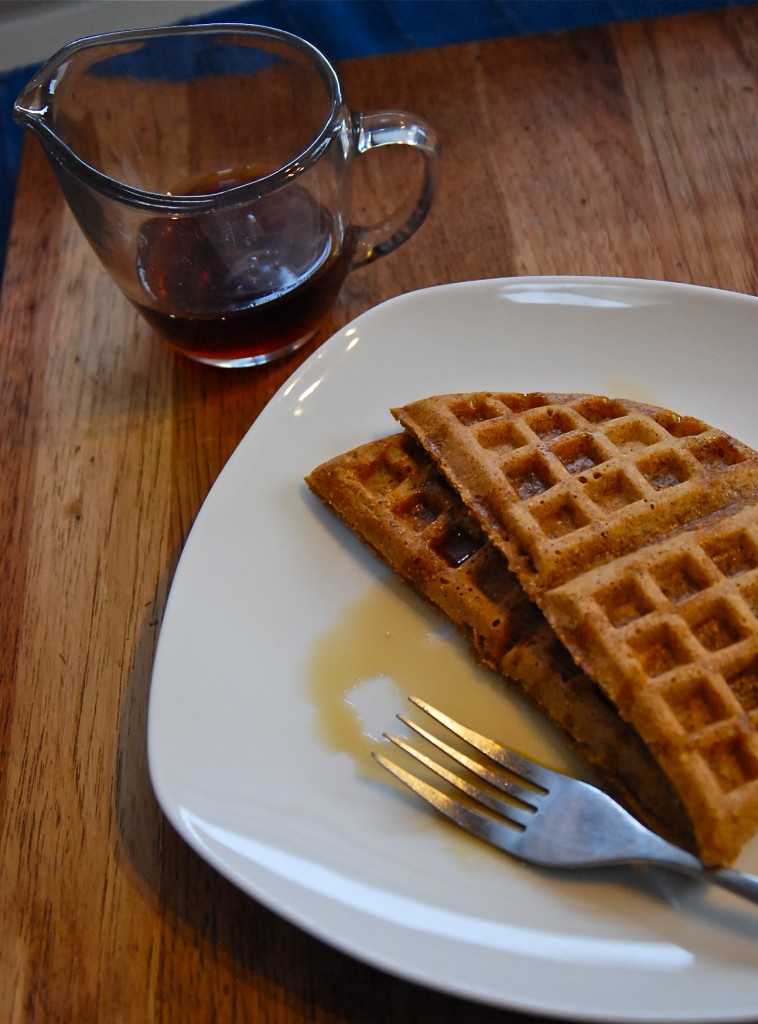
That burnished beauty isn’t exactly showing off it’s best in the photo, but that plain looking waffle is hiding a rich, spicy secret; cardamom, cinnamon and nutmeg, mingling with tiny chunks of tender sweet potato. A bit of inspiration, and an urge to start off the New Year with more than just the same old waffle, I reached for a container of cooked squash, opened the spice cabinet and crossed my fingers. The scent rising from the steaming waffle iron was heady and enticing; the first bite, amazing. Tangy with buttermilk, hearty with wheat flour and altogether a knock-out way to start 2012, this will definitely be on ‘Repeat’ for the remainder of Winter, whether it chooses to snow like crazy as it did last year, or remain mercilessly un-winter-like, there is one thing for sure; bellies will need filling, and this is the key that slips perfectly in to place.
Spiced Sweet Potato Waffles
3/4 c. whole wheat flour
3/4 c. AP flour
2 t. baking powder
1 t. baking soda
1/2 t. salt
1 t. ground cardamom
1 t. ground cinnamon
1/2 t. ground nutmeg
1 T. sugar (or honey would work too)
1-1/2 c. buttermilk (I like to use vanilla soymilk, and add two tablespoon vanilla yogurt for tang)
2 eggs
1/3 c. neutral flavored oil, such as rapeseed or canola
1 c. cooked mashed sweet potato or other cooked squash
In a large bowl, whisk together the wheat flour, AP flour, powder, soda, salt, cardamom, cinnamon, nutmeg and sugar. If using honey, add that to the wet ingredients.
In a separate medium sized bowl, add the buttermilk, eggs, oil and squash. Whisk until smooth. Add to the dry ingredients and gently fold together using a rubber spatula. Be sure to scrape across the bottom of the bowl to mix thoroughly. Do not overmix the batter. Allow to rest for 15 minutes. You’ll see bubbles form on the batter. Don’t stir it anymore.
Bake waffles according to your individual waffle maker. Mine makes 8″ round waffles, and I used 1/3 c. batter per waffle. This recipe made 6-8 waffles.
The original recipe used for this batter comes from The Breakfast Book, by Marion Cunningham.
December 27th, 2011
| 2 Comments »
There isn’t much now, that signifies Christmas was only two days ago, other than the abundance of chocolate in the house, the presence still of a tree with glittering ornaments and other holiday decor. The gift bags are empty and some treasured new items have been absorbed in to our days. Everyone seemed to have a good time this year. The stocking hunt was successful…..

The cats received fun new toys that they enjoyed…..
 
And there was plenty of gatherings, with laughter, delicious food and wine, more cookies than one could shake a leg at, and little children with bright happy faces. But just like that, the planning and preparing and decorating and plotting and going and coming and caroling and waiting waiting waiting was over…… *poof*…… just like that. You wake up on the 26th and it’s back to normal, back to reality, back to work (for some) and another Christmas is done. It seems like so much anticipation, and then in a blink it’s gone.
Some aspects remain, memories made and smiles shared and a new gift to use or enjoy. Or maybe, what remains most prominently is a smidgen of the amazing Cranberry Pound Cake that, on a whim, I whipped together and pushed in to the oven, before dashing upstairs to shower an hour before guests were due to arrive. It was still baking, rich and fragrant and eliciting all sorts of ‘What IS that in the oven?’ queries when my family arrived, and before coats were even shed.

And me, nonchalantly trying to avoid panicking, since the cake seemed off when I shoved the pan in the oven and raced off with a prayer, I just shrugged and said ‘Cranberry cake’ as if I’d just, you know, trimmed a nail or something because I really had little confidence it was going to be worthy of Christmas dessert. It was a blind preparation, something I’d never made before and I had everything I needed and took a chance. It seemed simple enough.
And thankfully, the alchemy of eggs, sugar, butter, flour and a hot oven created a masterpiece that I can’t wait to make again.

I get a bit overly excited each year when faced with orbs of fresh deep red cranberries in the store, and often stockpile as many bags as I dare in the freezer to use over the winter months. I spotted this recipe at Apartment Therapy (as usual….) and tucked it away to try, then of course, got caught up in the crazy whirlwind of pre-Christmas and neglected to make a dessert for our family gathering. But…. like I said, it worked despite a few reservations. In fact, it worked so well that I already am thinking about another go of it. I mean, by golly the initial cake isn’t even gone from it’s plate and I want another one. That HAS to be a good cake, right? It’s got an amazingly rich, yet light taste and a dense sponge to the cake, sweet but not cloying. Pops of deep cranberry flavor are laced with pure almond taste, and the crumbly sugary crust is simply divine. You could make this for an amazing dessert to impress, or you could just make it for yourself as a phenomenal treat.
Cranberry Cake
3 eggs
2 cups sugar
3/4 cup unsalted butter, slightly softened and cut into chunks
1 teaspoon vanilla
1 teaspoon almond extract (optional)
1 tablespoon kirsch (optional)
2 cups flour
2 1/2 cups cranberries (1 bag)
Preheat oven to 350°F. Lightly grease a 9×13 pan or a 10″ springform pan. You can also use a standard Bundt pan, or 10″ tube pan with removable bottom.
Beat eggs and sugar together for 8-10 minutes —no, this is not a misprint! …. the egg and sugar mixture should double in volume and turn pale yellow, leaving thick and shiny ribbons of batter when you lift the beaters. This is the only leavening in the cake so make it good and fluffy.
Add the butter and flavorings and beat for 2 more minutes. Stir in flour and fold in cranberries. Pour into greased pan.
Bake 45-50 minutes for a 9×13, or a little over an hour for the springform, bundt or tube pan. You made need to tent the cake with foil in the last 15 minutes or so to keep the top from browning too much.
Cool completely before serving.
Optional pecan topping:
1/4 cup butter
1/4 cup brown sugar
1 cup pecans, toasted
Heat the butter in a pan over medium-high heat. Add the sugar and stir. Add the toasted pecans and cook for several minutes, stirring, until the butter and sugar mixture is shiny and smooth and the nuts smell toasted. Spread over the cake batter and bake as above.
Original recipe, from Faith Durand at Apartment Therapy, The Kitchn.
~~~Next time I make this cake, I think the addition of fresh orange juice and freshly grated orange zest would be wonderful. Also, a scant 1/2 teaspoon of fresh grated nutmeg would also be marvelous. So many possibilities!!!
|




























